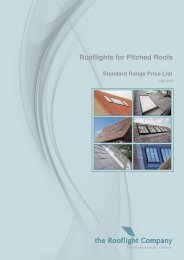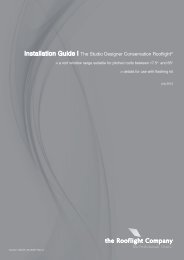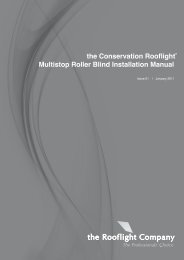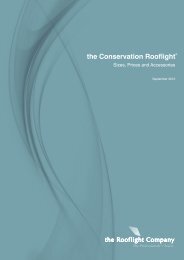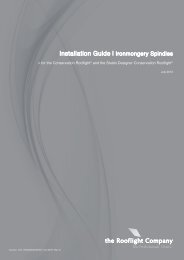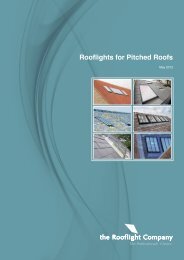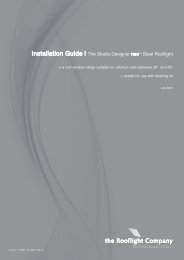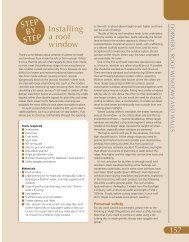neo Fortecom Installation Manual - The Rooflight Company
neo Fortecom Installation Manual - The Rooflight Company
neo Fortecom Installation Manual - The Rooflight Company
- No tags were found...
You also want an ePaper? Increase the reach of your titles
YUMPU automatically turns print PDFs into web optimized ePapers that Google loves.
SECTION 3 - Structural opening sizes> Type of roofBefore you can derive the structural framing dimensions you will need to understand which of the following options apply toyour project:ON THE RAFTER OR BETWEEN THE RAFTER<strong>The</strong> type of tiles used affects how the roof window is installed. One of the following options will be used:On the Rafter (Standard <strong>Installation</strong>):This installation (as the name suggests) installs the roof window with it sitting on top of therafters. For the majority of profiled tiles (Clay, Pantile etc) the roof window remains flush to thetop of the tiles and will not project above the finished roof line. For thinner tile types (Slate)the roof window will not be flush and will project above the finished roof line. If a flush detailis required for thin tile types then a ‘between the rafter’ (commonly referred to as Flush Slate)installation is required.Between the rafter (Flush Slate <strong>Installation</strong>):When tile types are thinner and a standard ‘on the rafter’ installation would result in a non-flushinstallation; a ‘between the rafter’ installation can be used. <strong>The</strong> roof window is sunk in betweenthe rafters to a depth equal to the height that it would protrude above the finished roof line ifa standard installation was used, nominally to a sunk depth of 20mm (Installers are advised tocheck this dimension prior to installation). Due to the roof window being sunk below the topof the rafters, the associated structural framing sizes increase. Likewise, dependent upon thepitch of the roof, the run-off required at the cill tilting fillet may vary. Nominally quoted framingsizes use the lowest installation pitch and calculate for worst case scenario.WARM OR COLD ROOF CONSTRUCTION TYPEstructuralopeningCold roofIn a cold roof construction,the insulation layer is placedhorizontally, directly abovethe ceiling of the upper storyof the habitable sectionof the building, usuallypositioned between thejoists in the loft space.structuralopeningWarm roofIn a warm roof construction,the insulation is positioneddirectly under the externalwaterproofing (e.g. tiles orslates), following the rafterline.INSTALLATION HEIGHT110 MAX<strong>The</strong> maximum height that can be used with the flashing kit is 110mm for all tiletypes. This is measured from the top of the soaker extrusion (part 6) to the topof the structural support (as shown). If your tiles are thicker than this then werecommend the use of lead soakers or mortar bed at the jambs.5
®SECTION SECTION99 3- Structural - Description opening sizes> Receiving > the Operation roof window detail> Transport & storageTILE TYPE: SLATE AND CLAY TILESTo derive the structural framing dimensions for <strong>neo</strong> <strong>Fortecom</strong>® <strong>Rooflight</strong>, you will need to have the following information tohand:uu<strong>The</strong> <strong>neo</strong> <strong>Fortecom</strong>® <strong>Rooflight</strong> model reference number to be installed.<strong>The</strong> type of roof construction to be used e.g. cold or warm.Derive the structural framing dimensions from the information below:Cold roof construction typeRoofwindowmodelStructural framingdimensionsWidth (mm) x Length (mm)structuralopening<strong>neo</strong> 38P<strong>neo</strong> 57P<strong>neo</strong> 63P<strong>neo</strong> 94P<strong>neo</strong> 150P907 x 1412907 x 18071062 x 16071062 x 21021387 x 2187<strong>neo</strong> 63L<strong>neo</strong> 94L<strong>neo</strong> 150L1402 x 12671897 x 12671982 x 1592Cold Roof -Insulation is between the rafters<strong>neo</strong> 41S<strong>neo</strong> 93S1062 x 12671387 x 1592Warm roof construction typeRoofwindowmodelStructural framingdimensionsWidth (mm) x Length (mm)structuralopening<strong>neo</strong> 38P<strong>neo</strong> 57P<strong>neo</strong> 63P<strong>neo</strong> 94P<strong>neo</strong> 150P687 x 1007687 x 1402842 x 1202842 x 16971167 x 1782<strong>neo</strong> 63L<strong>neo</strong> 94L<strong>neo</strong> 150L1182 x 8621677 x 8621762 x 1187Warm Roof -Insulation is above the rafters<strong>neo</strong> 41S<strong>neo</strong> 93S842 x 8621167 x 11876
®SECTION SECTION99 4 - Preparing - Description the roof> Receiving > the Operation roof window detail> Transport & storageFORMING THE STRUCTURAL OPENING<strong>The</strong> opening is formed using additional structural members which re-route the structural loads from the roof above, aroundthe structural opening.NOTE: All structural member sizing and fixings around the structural opening are to be asdetailed by the project architect/structural engineer. Our drawings are indicative only.<strong>neo</strong> <strong>Fortecom</strong>® <strong>Rooflight</strong>- in a new roof<strong>neo</strong> <strong>Fortecom</strong>®<strong>Rooflight</strong> - in an existing rooftrimmedrafterclearstructuralwidthtrimmingraftersjambstructuralsupportsnew trimmingrafters addednew structuralsupport rafterclearstructuralwidthremovedraftersectionclearstructurallengthclearstructurallengthtrimming raftersnew structuralsupport rafternew trimmingrafters addedIn a new roof the structural members can be designed toreduce the necessity for cutting and trimming.NOTE: <strong>The</strong> rafters and trimmers are doubled upin the imageIn an existing roof the structural opening may requireadditional structural members to be inserted and/orexisting members cut and re-supported in order to facilitateinstallation in the location required.NOTE: <strong>The</strong> rafters and trimmers are doubled upin the image8
SECTION99 4 - Preparing - Description the roof> Operation detail > Type of roof®HEIGHT OF THE STRUCTURAL BEARERS<strong>The</strong> intention of this installation guide is to achieve an installation of <strong>neo</strong> <strong>Fortecom</strong>® <strong>Rooflight</strong> that presents the glazingnominally flush to the general level of the top of the roofing material. Such an install achieves the inconspicuous appearancecharacteristic of <strong>neo</strong> <strong>Fortecom</strong>® <strong>Rooflight</strong>.It is most important that installers read and apply the contents of this section.INSTALLING THE STRUCTURAL BEARERSIn all installations <strong>neo</strong> <strong>Fortecom</strong>® <strong>Rooflight</strong> sits on structural bearers once installed. <strong>The</strong> positioning of the structural bearers isdependant on:u Roof type (e.g. cold or warm roof)u Roof finish (e.g. slate, clay tile etc)For flush installation the top of the structural bearers needs to be located 110mm below the general line of the roof finish.For cold roof installation the structural bearers need to be 100mm minimum height in order to accommodate the roofwindow baseplate within the roof cavity.Please see the worked examples below.Cold roofgeneral line of theroof finishWarm roofgeneral line ofroof finishWBP or marine plyliningA110mm110mm100mmMINABstructuralbearersstructuralbearersWBP or marine plyliningCSection at jambSection at jambCOLD ROOF(A) Thickness of roof finish (this is the dimension from the top of thestructural supports to the general line of the roof finish)(B) <strong>The</strong> depth the bearers sit below the structural memberWARM ROOF(A) Thickness of roof finish (this is the dimension from the top of thestructural supports to the general line of the roof finish)(C) <strong>The</strong> height the bearers sit above the structural memberIn this example A = 50mm (25mm batten + 25mm slate)<strong>The</strong> top surface of the bearers is required to be 110mm below the generalline of the roof finish.Where:B = 110 – A<strong>The</strong>refore: B = 110 – 50 B = 60mm (in this example)In this example A = 175mm (100mm insulation + 25mm counter batten +25mm batten + 25mm slate)<strong>The</strong> top surface of the bearers is required to be 110mm below thegeneral line of the roof finish.Where: C = A - 110<strong>The</strong>refore: C = 175 – 110 C = 65mm (in this example)9
SECTION 4 - Preparing the roof> Type of installationINSTALLING THE STRUCTURAL BEARERS - JAMBS AND HEADOnce the fixing height of the structural bearers is derived they can be fixed to the main structural supports.COLD ROOF: <strong>The</strong> structural bearers at the HEAD and JAMBS of the structural opening are to be two 50mm wide timbermembers. JAMB structural members bearers extend continuously from head to cill and the HEAD structural bearers are cut tofit within the jamb structural bearers. We recommend use of threaded rod fixings with large recessed washers and locknutsas shown below. Locating fixings at centres as specified by the project Structural Engineer.WARM ROOF: <strong>The</strong> structural bearers at the HEAD and JAMBS of the structural opening are to be 100mm wide and fixeddirectly on top of the structural support and trimming rafters. JAMB structural members bearers extend continuously fromhead to cill and the HEAD structural bearers are cut to fit within the jamb structural bearers as shown below. Fixing type andspacing to as specified by the project Structural Engineer.Cold RoofJamb & HeadWarm RoofJamb & Head1.2.3.1.COLD ROOFOn ‘thin’ roof constructions such as cold roof, <strong>neo</strong> <strong>Fortecom</strong>® rooflight’sare installed between the structural supporting rafters.WARM ROOFOn ‘thicker ‘ roof constructions such as warm roof, <strong>neo</strong> <strong>Fortecom</strong>®<strong>Rooflight</strong>’s are installed on top of the structural supporting rafters.<strong>The</strong> structural bearers should be strongly fixed to their flanking structuralsupports (see note above).Fixing components:1. locknut2. threaded bar3. washer<strong>The</strong> structural bearers require to be strongly screwed down onto thestructural supports. For larger <strong>neo</strong> <strong>Fortecom</strong>® rooflights consider usingstainless steel brackets in addition to screw fixings.1. screw fixings as specified by projects Structural Engineer10
SECTION 4 - Preparing the roof> Forming the structural openingINSTALLING THE STRUCTURAL BEARERS - CILLStructural bearers at the cill of the structural opening vary in position according to the roof covering type and roofconstruction method adopted. This is because differing roof tile types / roof constructions have different requirements inrespect of the length of runoff at the roof window cill in order to maintain adequate weathering capabilities.Fix the structural bearers to the cill of the structural opening in accordance with either the suggested installation details insection ‘Suggested installation details’ in this manual or a project-specific detail supplied by the project architect.NOTE:For large <strong>neo</strong> <strong>Fortecom</strong>® rooflights, the rotational loads placed upon the structural supports in cold roof installations mayrequire stabilisation with strutting or sheathing. Refer the suggested framing details appropriate to the roof type and finish,together with the roof window weight (see section ’Important information’ in this manual) to a Structural Engineer forchecking.cill structuralbearerCold RoofJamb & Cillcill runoff supportmembersWarm RoofJamb & Cillcill structuralbearerjamb structuralbearertrimmingraftersjack bearerinsulation infillconsider using steel fixingbrackets here when jackbearers are used.trimmingraftersCOLD ROOFWARM ROOFOn ‘thinner’ roof constructions such as cold roof, <strong>neo</strong> <strong>Fortecom</strong>®<strong>Rooflight</strong>’s are installed between the structural support rafters.On ‘thicker’ roof constructions such as warm roof, <strong>neo</strong> <strong>Fortecom</strong>®<strong>Rooflight</strong>’s, are installed on top of the structural supporting rafters.<strong>The</strong> cill structural bearers are located within the structural opening andthe cill runoff supporting members are generally located within thestructural length.<strong>The</strong> cill structural bearer is located on top of the structural supportmembers and the cill runoff supporting members are generally locatedoutwith the structural length.See also the section ‘Suggested installation details’ in this manual.See also the section ‘Suggested installation details’ in this manual.11
SECTION 4 - Preparing the roof> Prepared opening> Cill tilting filletCSWCSLpPrepared OpeningTrim the opening within the roof to the correct size required for themodel of the roof window being installed.uInstall the cill tilting fillet (we recommend hardwood or treatedsoftwood). Its purpose is to support the cill flashing and flashingsubstrate. Note: Details shown here are for COLD ROOF construction.See section ‘suggested installation details’ in this manual forappropriate WARM ROOF detail.qCill tilting filletRoofingMembraneTilting fillet12
SECTION 4 - Preparing the roof> Roofing membrane tray> Cill flashing substrateRoofingmembranetraypRoofing membrane trayInstall a roofing membrane tray at the cill of the opening as shown.<strong>The</strong> membrane tray is to pass over the cill tilting fillet and terminateover the general roofing membrane.Install a 15mm thick WBP or marine-quality ply flashing substrateat the cill of the opening as shown. It is to be installed over themembrane tray shown above and of sufficient length to ensure thatthe cill flashing finishes at the height of the cill rooftiles. Ensure a5mm MIN gap between the 2 halves of the substrate.qCill flashing substratePly flashingsubstrate14
SECTION 4- Preparing the roof> Battening up the cill> Battening up the jambspBattening up the cillIt is recommended that the roof is battened up to the cill of theopening, at this stage. Ensure that the roofing membrane tray whichwas previously fitted is located underneath the battens. Battenspacing is determined by the roof covering being used. Adjust thebattening and tiling to course and fit around the structural opening.When battening around the opening the battens at the jambs are tocome up to the outside faces of the structural opening (COLD ROOF)as shown. Whilst installing these make sure that the ends of thebattens are only ‘tacked’ in place at this stage. This is to ensure the roofwindow is weathered in correctly at a later stage of the installation.qBattening up the jambs15
SECTION 5 - Installing the roof window> Lead cill flashing> Installing the roof windowLead flashingpLead cill flashingInstall a code 3-5 lead flashing (depending upon the weather exposure)to the cill of the opening as shown. Side lap to be minimum 150mm.Length of flashing to be sufficient to give the tile-recommendedheadlap. Lay a continuous thick bead of low-modulus neutral curesilicone along the flashing.Lift the roof window into the opening being careful NOT to pick the roofwindow up by the perimeter extrusion or cill flashing.If your roof window model has a motorised configuration, be sure toallow enough room the cill of the roof window for the cable to escapethe frame without becoming trapped or over-twisted.qInstalling the roof window16
SECTION 5 - Installing the roof window> Fix> Perimeter silicone filletWasherSpring washerCoach screwspFixLocate all of the fixing points at the perimeter of the roof window. Drill pilotholes and fix the coach screws with a large flat washer and a spring washerthrought and into the structural support. ONLY TIGHTEN THE COACH SCREWSUNTIL THE SPRING WASHER HAS FLATTENED OUT. OVER TIGHTENINGOF THE COACH SCREWS CAN CAUSE DAMAGE TO THE ROOF WINDOWFRAME, IT MAY BE NECESSARY TO PACK BEHIND THE FIXING RAIL. Ensurean even number of coach screws are used across each jamb.Install a thick continuouse fillet of low-modulus neutral cure silicone tothe full length and width of the jambs and head of the roof windowperimeter.qPerimeter silicone fillet17
SECTION 5 - Installing the roof window> Installing the head flashing> Installing the head roofing membraneHead flashingNOTE: If this meets thenext lap of the generalroofing membrane,ensure it is tuckedunder the lap as shown.pInstall the head flashing<strong>The</strong> felt attached to the jamb flashings should go OVER the generalroofing membrane but UNDER the battens which may be in place.Repeat for the opposing side. Next, lay the head flashing over the headfillet. Fold, boss and tuck the flashing back into the baseplate rollover.<strong>The</strong>re may be a requirement to trim the head flashing around the jambbattens depending upon their positioningLay the strip of roofing felt over the head flashing and ensure it tucksUNDER the next lap in the general roofing membrane.qInstalling the head roofing membraneHead roofingmembrane19
SECTION 5 - Installing the roof window> Soakers> Tile the jambsSoakerpSoakersWhen laying the second course of tiles at the jambs, soakers arerequired; one per jamb. Lay the soaker flashing over the edge of the cillcorner and form the soaker, ensuring it tucks BEHIND the jamb flashingextrusion as shown.Use the edge of the jamb flashing as a guide to tile up to and tile thejambs. Ensure the weathering foam attached to the jamb flashingsis folded down and away from the roof window when laying thetiles.qTile the jambs21
SECTION 5 - Installing the roof window> Complete the tiling> Installing the head and cill timber liningspComplete the tiling<strong>The</strong> head of the roof window can now be tiled. We recommend the useof eaves tiles. Complete the tiling around the head of the roof windowaccordingly.Install the cill and head linings as shown. Orientate the lining withthe fixing holes aligned to the securing brackets located in the roofwindow baseplate recess. (as shown by the dashed line in the belowimage). Secure in place using screws provided. Cover the screw headsby inserting the timber plugs until flush to the surface of the lining.qInstalling the head and cill timber liningsHead timber liningCill timber lining22
SECTION 5- Installing the roof window> Installing the jamb timber linings> Drawing identificationJamb timber liningpInstalling the jamb timber liningsInstall the jamb linings as shown. <strong>The</strong> installation method is the sameas that used for the head and cill linings.23
SECTION 7 - Important Information> Care & maintenance> Conformity> AdvisoryCARE & MAINTENANCETo achieve the maximum service life from the <strong>neo</strong> <strong>Fortecom</strong>® <strong>Rooflight</strong> it is important that scheduled care andmaintenance is undertaken. Please note that the guarantee may become void if the procedures outlined in the separatemaintenance manual are not adhered to. Refer to separate TECHNICAL SPECIFICATION AND MAINTENANCEDETAILS.CONFORMITYRefer to separate DECLARATION OF PERFORMANCE DOCUMENTATIONEN 14351-1 : 2006+A1: 2010ADVISORYStandard roof window: All the information provided in this document refers to a standard specification <strong>neo</strong><strong>Fortecom</strong>® <strong>Rooflight</strong>Install in accordance with national building regulations/codes. This manual is an installation suggestion andinstallers should verify ‘fitness for purpose’ in accordance with all applicable regulations/ standards at time ofinstallation.Install in accordance with this manual: <strong>The</strong> <strong>Rooflight</strong> <strong>Company</strong> cannot accept any liability if the <strong>neo</strong> <strong>Fortecom</strong>®<strong>Rooflight</strong> is not installed strictly in accordance with the instructions contained in this manual and implicit in the‘Suggested <strong>Installation</strong> Details’.Structural support: Structural supports for the <strong>neo</strong> <strong>Fortecom</strong>® <strong>Rooflight</strong> are to be designed and supervised duringconstruction by the roof window installer or project Structural Engineer. Nothing in this manual constitutes astructural proposal. Sizing/positioning of structural supports should be determined by the projects suitably qualifiedstructural engineer.28
SECTION 7 - Important Information> Roof window weight and opening angle> Further InformationROOF WINDOW WEIGHTSWhen handling and installing the <strong>neo</strong> <strong>Fortecom</strong>® <strong>Rooflight</strong> its weight should be considered and adequate means employed tomove the roof window into position to reduce the risk of accidents.MODELREFERENCENUMBEROVERALL ROOFWINDOWWEIGHT (KG)NF38P 54NF41S 54NF57P 67NF63P 68NF63L 68NF93S 82NF94P 87NF94L 87NF150P 108NF150L 108PRODUCT IDENTIFICATION DETAILSPlace identification sticker here or fill in the following details.Serial number:________________Model Number: ___________Date of manufacture: __/__/____FURTHER INFORMATIONAll of the images in this guide are diagrammatic (with some components omitted for clarity). <strong>The</strong>y should be used as a referenceand may not be a true representation of the installation.<strong>Installation</strong> instructions are regularly reviewed and we reserve the right to update or amend these details without alteration tothis guide.July 201329
30NOTES
NOTES31



